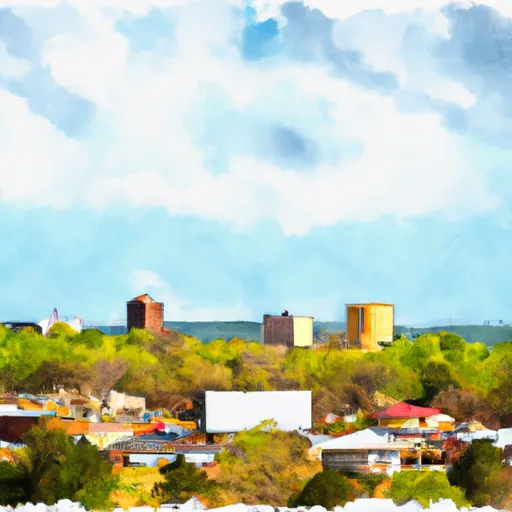-
 Snoflo Premium
Snoflo Premium
Get unlimited access to all our content
With no Ad interruptions! - Start Your Free Trial Login with existing account
Witts-Springs
Eden Index
Climate
7.9
•
Recreation
5.0
•
Community
•
Safeguard
4.9/10

Witts-Springs, Arkansas is a charming rural community located in Searcy County. It has a humid subtropical climate characterized by mild winters and hot, humid summers. Average temperatures range from 40°F (4°C) in winter to 90°F (32°C) in summer, with occasional snowfall during the colder months and frequent thunderstorms in spring and summer.
The region is known for its rich hydrology constituents, with numerous springs, rivers, and creeks dotting the landscape. Witts-Springs is surrounded by the Ozark National Forest, ensuring an abundance of natural beauty and recreational opportunities. The area is ideal for fishing enthusiasts, with the Buffalo National River and Richland Creek nearby, offering opportunities to catch various fish species.
Outdoor enthusiasts will find plenty of opportunities for activities like hiking, camping, and wildlife viewing in the surrounding forests. Witts-Springs is also home to the Bear Creek Lake, where visitors can enjoy boating, swimming, and picnicking. With its scenic landscapes, diverse wildlife, and ample water resources, Witts-Springs, Arkansas provides an idyllic setting for nature lovers and outdoor adventurers.
What is the Eden Index?
The Snoflo Eden Index serves as a comprehensive rating system for regions, evaluating their desirability through a holistic assessment of climate health, outdoor recreation opportunities, and natural disaster risk, acknowledging the profound impact of these factors on livability and well-being.
Climate Health Indicator (CHI): 7.9
Witts-Springs receives approximately
1298mm of rain per year,
with humidity levels near 81%
and air temperatures averaging around
14°C.
Witts-Springs has a plant hardyness factor of
7, meaning
plants and agriculture in this region tend to thrive during the non-winter months.
By considering the ideal temperature range, reliable water supplies, clean air, and stable seasonal rain or snowpacks, the Climate Health Indicator (CHI) underscores the significance of a healthy climate as the foundation for quality living.
A healthy climate is paramount for ensuring a high quality of life and livability in a region, fostering both physical well-being and environmental harmony. This can be characterized by ideal temperatures, reliable access to water supplies, clean air, and consistent seasonal rain or snowpacks.
Weather Forecast
Streamflow Conditions
Upper White
Area Rivers
Upper White
Snowpack Depths
Upper White
Reservoir Storage Capacity
Upper White
Groundwater Levels
Recreational Opportunity Index (ROI): 5.0
The Recreational Opportunity Index (ROI) recognizes the value of outdoor recreational options, such as parks, hiking trails, camping sites, and fishing spots, while acknowledging that climate plays a pivotal role in ensuring the comfort and consistency of these experiences.
Access to outdoor recreational opportunities, encompassing activities such as parks, hiking, camping, and fishing, is crucial for overall well-being, and the climate plays a pivotal role in enabling and enhancing these experiences, ensuring that individuals can engage in nature-based activities comfortably and consistently.
Camping Areas
| Campground | Campsites | Reservations | Toilets | Showers | Elevation |
|---|---|---|---|---|---|
| Corney Lake Complex | 25 | 121 ft | |||
| Cloud Crossing Complex | 13 | 130 ft | |||
| Gum Springs Complex | 30 | 264 ft | |||
| Coyote Camp Complex | 13 | 367 ft | |||
| Turkey Trot Complex | 25 | 261 ft | |||
| Oak Camp Complex | 23 | 300 ft | |||
| Lake Claiborne State Park | None | 337 ft | |||
| Colfax Rec Area Campground | 25 | 96 ft | |||
| Custis Camp Complex | 10 | 302 ft | |||
| Bucktail Camp Complex | 40 | 296 ft |
Nearby Ski Areas
Catastrophe Safeguard Index (CSI):
The Catastrophe Safeguard Index (CSI) recognizes that natural disaster risk, encompassing floods, fires, hurricanes, and tornadoes, can drastically affect safety and the overall appeal of an area.
The level of natural disaster risk in a region significantly affects safety and the overall livability, with climate change amplifying these risks by potentially increasing the frequency and intensity of events like floods, fires, hurricanes, and tornadoes, thereby posing substantial challenges to community resilience and well-being.
Community Resilience Indicator (CRI):
The Community Resilience Indicator (CRI) recognizes that education, healthcare, and socioeconomics are crucial to the well-being of a region. The CRI acknowledges the profound impact of these elements on residents' overall quality of life. By evaluating educational resources, healthcare accessibility, and economic inclusivity, the index captures the essential aspects that contribute to a thriving community, fostering resident satisfaction, equity, and social cohesion.

